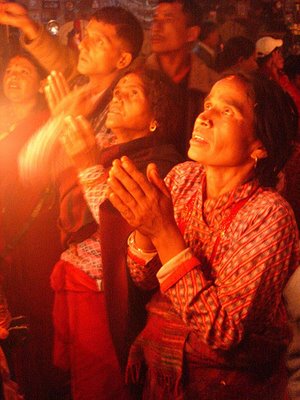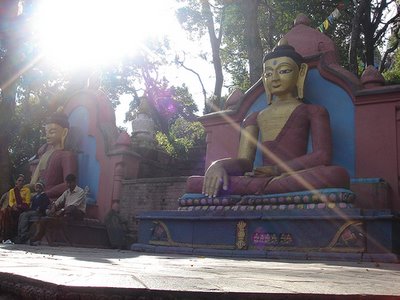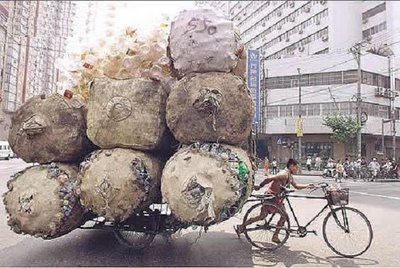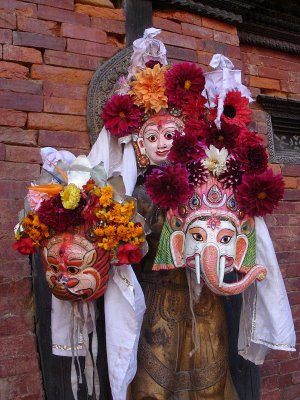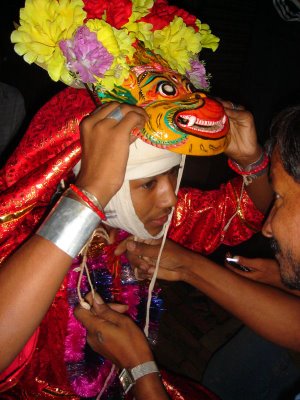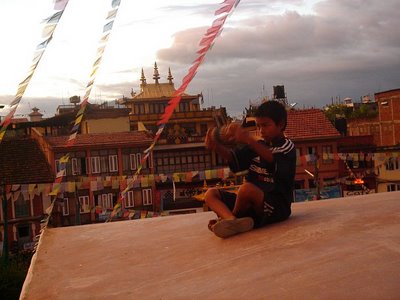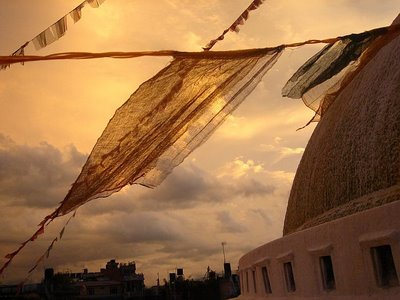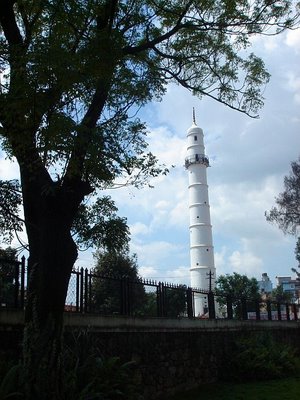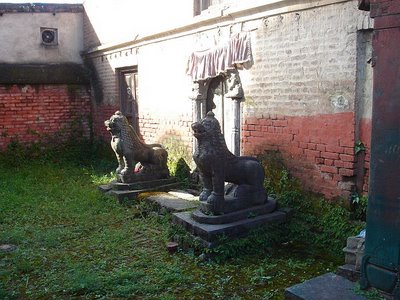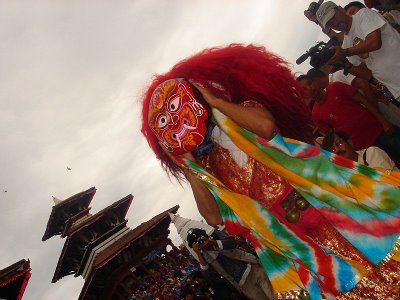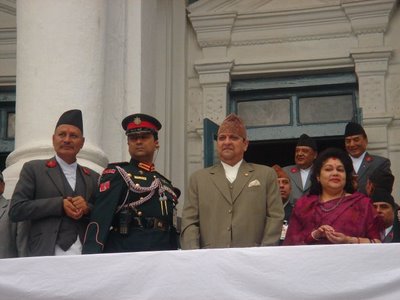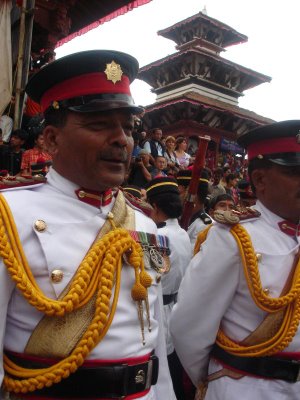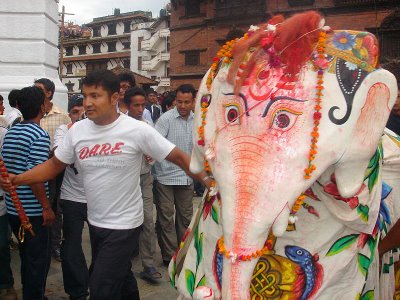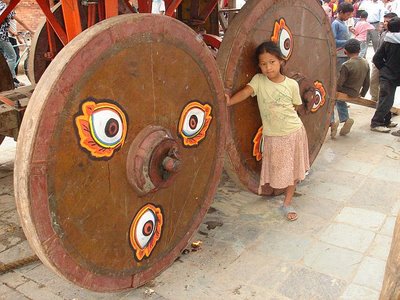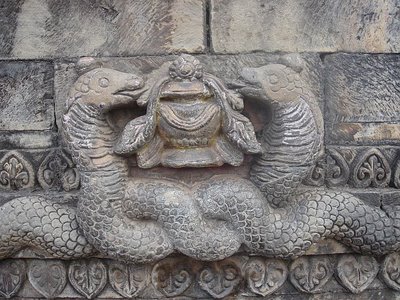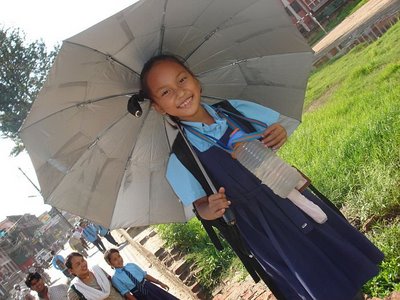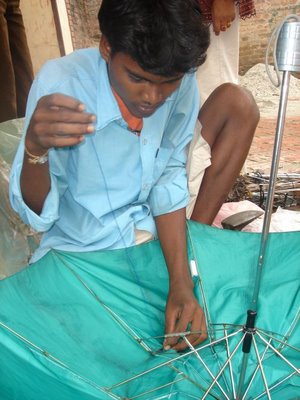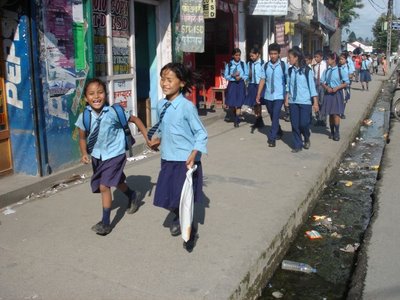Bodh Gaya, Bihar, India
I got a bike! Man, it has been more than three years since I rented a bike back in Mysore. Indian rental bikes are just standard cheapo upright "push-bikes," but they have an ingenious locking device. A steel ring locks into place round the back tire (here it's spelt "tyre") so it can't be moved when you park the bike. Of course, this would never work in Manhattan - guys would just come along with a van and load all the bikes inside. In nine years, I never did figure out a way to outwit Manhattan bike thieves.
This bike is 25Rs a day (about 50 cents) and is perfect for flat, dusty Bodh Gaya. It's fun chiming the bell as I weave through traffic. I do have to wear a mask - that is, an emissions mask. It's so common to see people wearing them here (elastic straps, fabric guard fitted over nose and face) that it seems positively normal now. People even sit around tables indoors having conversations wearing them, and never remove them. Between the burning garbage, the vehicle pollution and all the nasty smells, I think masks (or maybe the full burqa) are now mandatory in Indian cities.
I had to go to the bike place four times before I actually got a bike. First time (at 10AM) Satish said "no bike now, come back in one hour." I came back at 12.30 and still there was "no bike, come back after some time." I returned at 5.30. Satish said, "Oh, bike was here but you did not come, so he went away," - and told some totally irrevelant story about his brother going to the market to buy vegetables. "Come back after one half hour." Fourth time was the charm.
Better than champagne or confetti
See my new story about the Tibetan vegetarian movement, on Phayul.com, the premier Tibetan news service.
Turn your scars into stars
It's Day Five of the 24th annual Kagyu Monlam, a nine-day world peace prayer festival here in Bodh Gaya, where the original Buddha gained enlightenment.
 Each evening, His Holiness the 17th Karmapa has been delivering teachings at his newly inaugurated (and rather sumptuous) monastery. The usual enormous crowd showed up more than one hour early to go through security clearance and bag checks. Tonight's message was advice for the coming New Year.
Each evening, His Holiness the 17th Karmapa has been delivering teachings at his newly inaugurated (and rather sumptuous) monastery. The usual enormous crowd showed up more than one hour early to go through security clearance and bag checks. Tonight's message was advice for the coming New Year.Transform troubles into treasure
“The painful difficulties we have experienced in the past year are not to be put aside as too painful to be considered, nor to be ignored. Rather, difficulties and challenges should shape the contours of one’s life and character, and define the quality and vision of one’s life.
"For example, I personally have faced difficult and critical times in my life – particularly in the period from 1999 to 2000," he said, referring to the time of his dramatic and dangerous escape from Chinese-occupied Tibet into exile in India. "Decisions and activities undertaken at that time were challenging and difficult - needless to say - as many of you are aware. Yet, looking back, the challenges I faced have become the adornment of my life. Maybe, if I had not gone through these difficulties, I would be more anonymous, less distinguished in my character. "So in this way, each one of us, if we face difficulties, must embrace difficulties in our lives as a blessing in disguise, so to speak – as lessons, things to be learned from. Then only the difficulties and hard times can adorn one’s life – only when one can find beneficial lessons in them.
"Ideally, your problems experienced in the past year should be used as fuel for greater development in the coming years, so they become attributes - so that they add to the expression of your human dignity, fullness, and repleteness. In that way, you are decorated and ornamented by learning from your difficulties.
"If you could take this approach to the past year’s problems, this would indeed be very precious.
Leave the past behind
"If you fail to do so - if you cannot transform your troubles - the next best approach is to put aside, to let go of problems of the past. Don’t bring them into the New Year. Do not let all old the baggage, burdens and problems come trailing you into the New Year. Come with a fresh start. In my own case, in 2006, guiding the Kagyu Monlam has had its own share of difficulties and challenges. But tonight, I come to you afresh – cleansed and crystal fresh.
"It’s my hope that you will resonate with that freshness, and preferably learn to make use of those difficulties to dignify and decorate your life. But if not, at least, say “goodbye” to them. You need room for the new events of the coming year. Do not enter the New Year already filled with things you can’t say goodbye to.
"We need to realize clearly that time does not control us, nor customs. The time and custom of the New Year is not going to dictate the change in our lives. That would be a very mistaken approach. Our own willingness, that we feel inspired and motivated to change – will bring the change from within ourselves. We can change any time we choose.
The reason for Dharma practice
"The principal purpose of Dharma practice, and the reason for the Buddha’s teachings, is to change our conditioned, habitual views. Our conditioned view is a fanatical fixation to whatever illusion or notion of reality we have. The Buddha’s teaching is to undo this – to help us understand the danger of that rigidity, that fixation. Do not use your Dharma practice to develop yet another view, and then become fixated on that view. Gradually, on our path, we go beyond any view. "In this way, when we approach Dharma practice and everyday activity, we should approach with attitude free of extreme fixations. In life we face challenges and difficulties. We should be conscious of the fact that there is room for flexibility, room for movement in each situation. We do not have to be stuck with the problem. By not becoming fixated or rigid, we begin to see room for possibilities.
"It is important to know, for Dharma practice, that we are not particularly trying to promote this view or that view. We already have enough views and enough opinions – we don’t need more. Especially, we don’t need to learn or have a new view that becomes fixated and concrete.
"We actually need a genuine experience of peace of mind, experience of state of stability of mind. We need greater mental capacity for what is good and authentic. This is not dependent on how long you’ve been practicing Dharma – rather, it depends on what, on a daily basis, is going on with one’s life and outlook. It depends on the attitude you are developing on a day to day, week to week, month to month basis. What depth and profundity of loving kindness and compassion have we been able to develop?
Take responsibility
"There are two very important things: First is proper guidance. Second, examples – examples of wholesome and virtuous activities and attitudes to be embraced. But direction and examples are not enough. These come from outside. One must recognize one’s own pressing responsibility of embracing what must be embraced, and giving up what must be given up. "In terms of self-help, what to do? We literally feed ourselves three times a day, but even the food that we think is for ourselves feeds countless other living organisms. Seen this way, the sense of 'I' has no fixed reference that we can put our fingers on. That being so, maybe we should instead feed our minds three times a day - or at least, twice a day, for sustenance of mind, and maturity. Maybe we need mental vitamins!
Buddhas from abroad
"In conclusion, I would like to say that I’ve heard there are some 1,000 of you here from abroad. To me, you are like 1,000 Buddhas and Bodhisattvas. Actually, I don’t know what Buddhas are supposed to look like, but this time, the Buddhas have different shades of hair, some have golden hair; some are tall, some are short. I am so amazed with the varieties of the Buddhas, and the variety of ways the Buddha can manifest. That you have all come here, and participated sincerely and genuinely in the Kagyu Monlam, I feel strengthened by all your presence. I feel invigorated by your presence. I feel that because of you all, I must do more.
"For this show of strength and unity, I would like to thank you all. We are inseparably linked. You all are a source of benefit for me. In that spirit and on the eve of the New Year, I extend to you whole-hearted wishes of happiness, well-being and that we remain connected. If we experience happiness, we will do it together. If we experience suffering, we will do it together.
And with this, I wish you all the best. Tashi Delek to all."
To the delight of the crowd, His Holiness said, “Happy New Year” in English. He bowed his head with hands pressed together in traditional "Namaste" salute, stood up, and strode off the stage waving "bye-bye" playfully like a small child.
Everyone poured out the giant red front doors, to be greeted by a surprise fireworks display. The red, blue, green and gold fireworks mingled with the red, blue, green and gold Tibetan archway. Under a near-full winter moon, Buddhas of all nations exchanged embraces and wishes for a Happy New Year. This romantic scene was eventually disrupted by the reality of having to get out of the monastery - an Indian traffic jam of cycle rickshaws, mammoth tour buses, auto-rickshaws, pedestrians and beggars.
I hung back for a bit, circling the monastery clockwise on my new bike for good merit. When a space appeared, I weaved my way through the stalled vehicles and clouds of diesel fumes, down the unpaved road back to town.
HH the Karmapa photo courtesy of Kagyu Office website.
 Here is the old national crest. It incorporates a modern Gurkha soldier, a traditional soldier of ancient times, mountains, the royal crown, crossed khukri knives, rhododendrons, national flags, Sun and Moon, footprints of Gorakhnath (patron deity of Gorkha, the king's homeland), and a few other things I can't make out.
Here is the old national crest. It incorporates a modern Gurkha soldier, a traditional soldier of ancient times, mountains, the royal crown, crossed khukri knives, rhododendrons, national flags, Sun and Moon, footprints of Gorakhnath (patron deity of Gorkha, the king's homeland), and a few other things I can't make out.


